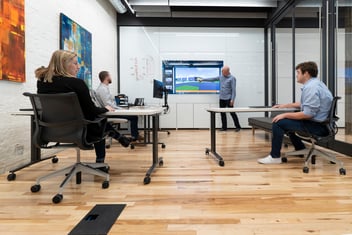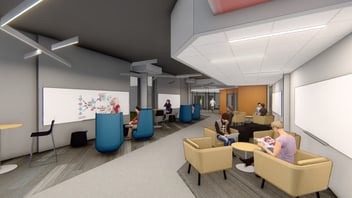
If you’ve spent any amount of time on a well-designed university campus, then you understand the importance of architecture when it comes to influencing higher education. Not only can architecture inspire imagination and creativity, but it can unite students, educators, and the community. Campus life is now becoming increasingly important as institutions of higher education adapt to shifting trends from technology to funding sources. Supporting both the recruitment and retention of high caliber students, well-designed colleges serve as showpieces, differentiating the institution in the eyes of prospective students. Take at look at these design strategies and get inspiration for your next campus project!
Creating Vertical Spaces
Many college campuses are very large which can make it easy for designs to focus on the outward appearance. But, while often beautiful to look at, there can be a feeling of being "lost in a crowd," making these types of buildings and spaces less than conducive to interaction and collaboration. Instead, higher education facilities may want to look at finding ways to build up – not out. These sorts of vertical spaces, when designed for students and faculty in particular, become a powerful magnet for interaction, allowing individuals on campus to feel less “lost” and more as part of the crowd.
Putting Your Students First
Students want to feel like they belong on your campus – and that can be accomplished through great design. When creating a space, it's important to look at developing areas that are convenient for students to enjoy. Places to safely store laptops and personal items in between lectures, attractive lobbies with comfortable and adaptable furniture, as well as large seating areas where bigger study or friend groups can meet will help to bolster the attitude and loyalty of students on campus. Anticipating the needs of your students is the first step to creating an attractive campus.
Natural Light
Natural light is something we've got in depth on before, so we won't rehash all of it, but natural light is very important in campus design so it would be a disservice not to at least bring it up. In short, many studies confirm that natural light leads to student success. In addition to success, natural light is said to make people happier, reduce stress, and combat illness. By finding ways to allow for more natural light, facilities can improve the environment for everyone working and learning on campus. You may also want to consider creating spaces that are truly light-filled such as a wall of windows or clear walls. Spaces such as these can help make studying and meetings significantly more enjoyable.
Designing For Inclusivity
One of the more interesting – even ground-breaking – ideas relative to inclusivity is the intentional placement of freshman and seniors on the same residential floor or hall. With the exception of residential colleges, most universities and colleges have historically separated lower and upperclassmen housing. If you want to take your campus life to the next level, consider looking at co-locating these groups for the purposes of built-in mentoring, increased retention and scholastic achievement, and the mutual benefit of modeled behavior. From a design standpoint, we are finding clever new ways to place typical upperclassmen units – like apartments – alongside lower classmen semi-suites. This concept of mixing classes embraces a collective identity, encourages multi-class interaction, and promotes a longer, stronger affiliation with the institution. Overall, designing for a better campus life is a matter of inclusivity in both the individual and collective sense. Student life spaces must be made welcoming, customizable, and enable students to leave their own personal signature. Doing this well will require an increased focus on collective student support, unique school pride, and multi-class and multi-age collaborations. Do you want your students to have an extraordinary campus experience? Give us a call! We'd love to discuss your project with you.


